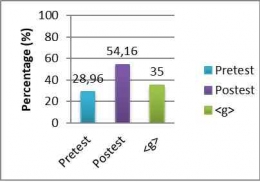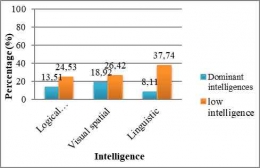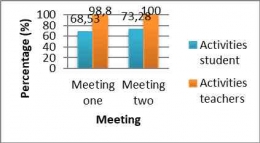Based on figure 4.3 is known that the average score obtained by students prior to teaching a class experiment pretest was still low at 7.24, while after learning by using multiple intelligences learning based on average posttest score was increased to 13.54. Difference in mean value between pretest and posttest is indicated by the value of the gain that is equal to 6.30. When viewed from the gain normalized, then there was an increase in students' mastery of the concept of multiple intelligences after learning based categories are included with a value of 0.35 so it can be said that the mastery of the concept of IPBA student based learning applied to increase after multiple intelligences.
Here is a profile of intelligences in students who can be seen in Figure 4.4. Below:

From the profile of intelligence on concept mastery test IPBA junior high school students who viewed only four intelligences that is logical mathematical, visual spatial, naturalist, and linguistics. It was found that students intelligence dominant naturalist with the percentage of 55.26% and the low linguistic intelligence with the percentage of 34.55%. Seen that students were used to link the learning materials with everyday life. This needs to be trained and socialized so that students know the benefits of science he had learned to everyday life that they experience. But either questionnaires or tests students' mastery of concepts intelligences low on linguistic, indeed it needs more effort to train students in classroom discussions and to familiarize students to participate in class discussions.
4. Conclusions
Based on the results of research and analysis of data obtained the conclusion is there was an increasing mastery of the concept of applied learning based IPBA after multiple intelligences seen from the normalized gain of 0.35 in moderate category. Intelligence profiles after multiple intelligences based learning applied to the average student is dominant intelligences Naturalists with a low percentage of 55.26% and linguistic intelligences with a percentage 34.55%. The percentage of the average profile of the student activity at the first meeting which is 68.53% while the average percentage of the activity profile of students at a second meeting is 73.28 which are both categorized properly.
5. References
- Depdiknas. (2006). Kurikulum Tingkat Satuan Pendidikan Sekolah Menengah Pertama. Jakarta: Depdiknas.
- Hake, R. R. (1998). Interactive Engagement Methods In Introductory Mechanics Courses. Departement of Physics, Indiana University, Bloomingtoon. [Online]. Tersedia: http://www.physics.indiana.edu/~sdi/IEM-2b.pdf. [7 Desember 2007]
- Kaya, O. (2008).How Is A Science Lesson Developed And Implemented Based On Multiple Inteligences Theory. [Online].Tersedia:http://www.eric.ed.gov/ERICWebPortal/search/detailmini.jsp?_nfpb=true&_&ERICExtSearch_SearchValue_0=EJ802521&ERICExtSearch_SearchType_0=no&accno=EJ802521.
- Sugiyono. (2006). Metode Penelitian Pendidikan (Pendekatan Kuantitatif, Kualitatif dan R&D). Bandung: Alfabeta
Follow Instagram @kompasianacom juga Tiktok @kompasiana biar nggak ketinggalan event seru komunitas dan tips dapat cuan dari Kompasiana. Baca juga cerita inspiratif langsung dari smartphone kamu dengan bergabung di WhatsApp Channel Kompasiana di SINI










